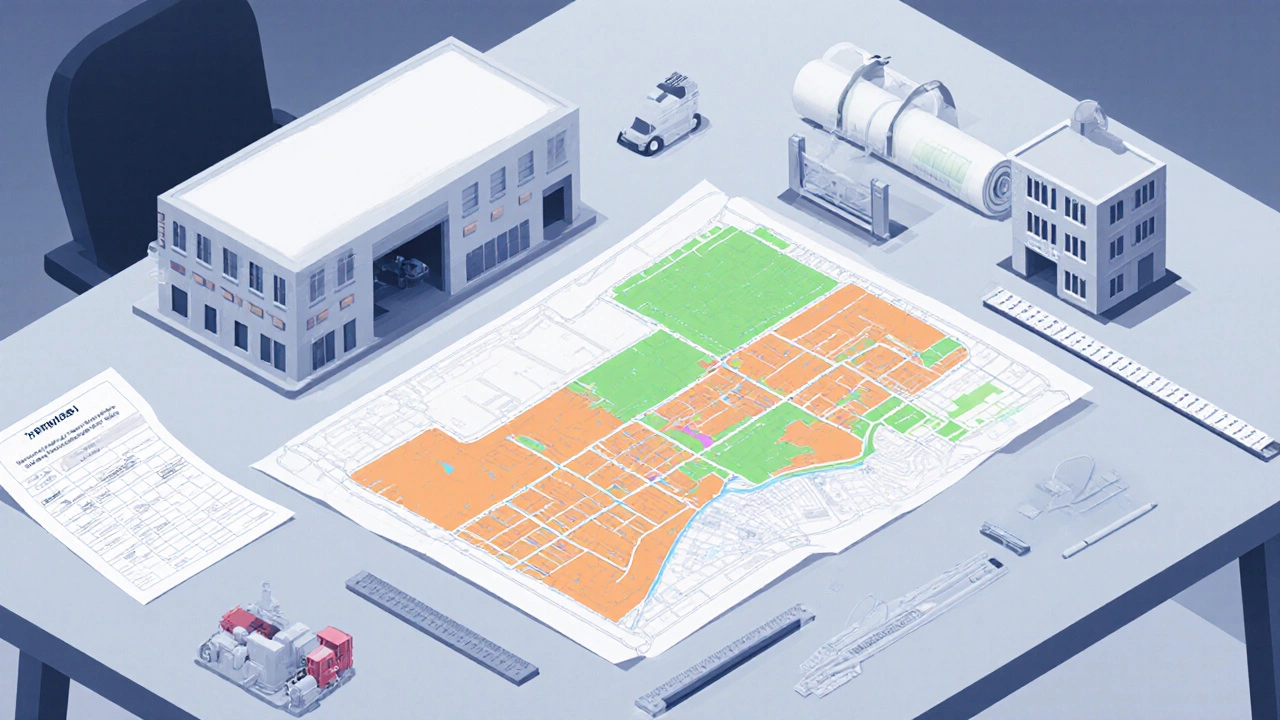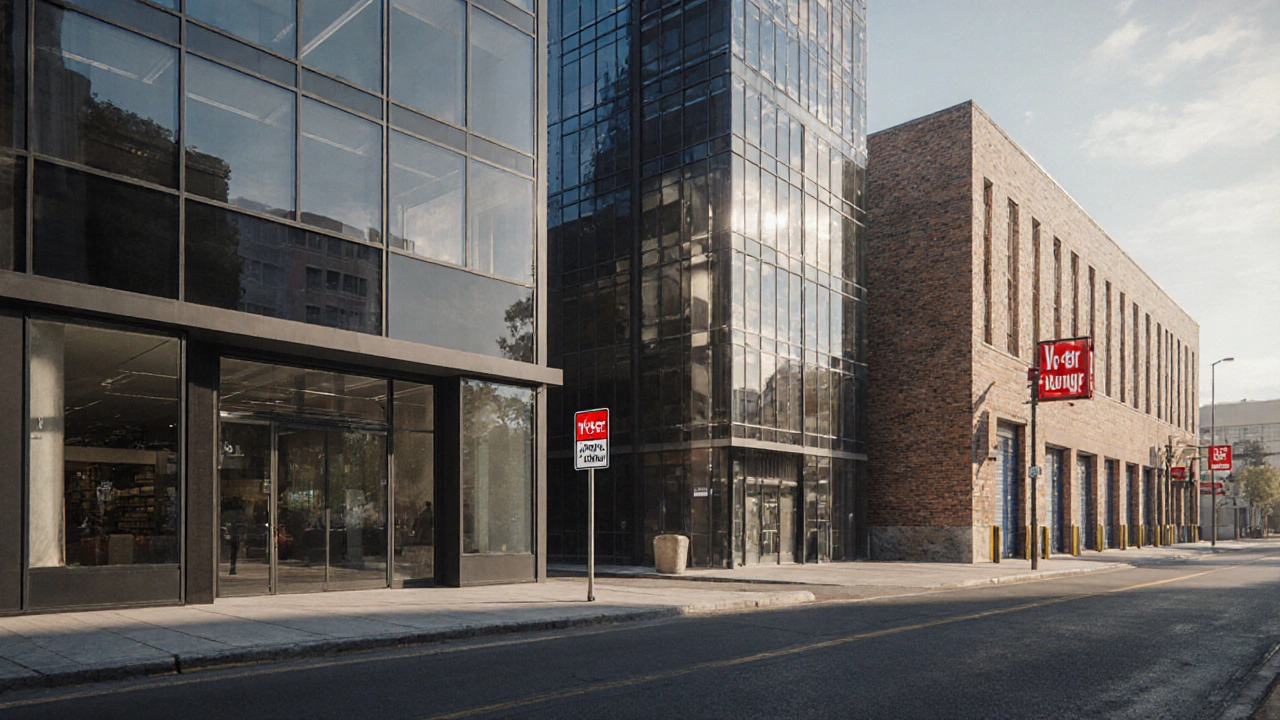Commercial Property Classification Checker
This tool helps you identify whether a property is classified as commercial by evaluating key criteria. Click on each criterion to mark it as applicable, then review your results.
Zoning Designation
Is the property zoned for commercial use in the local council's district plan?
Intended Business Use
Is the primary use a business activity (selling, servicing, producing)?
Floor-Area Ratio (FAR)
Does the building exceed typical residential floor-area limits?
Access and Parking
Does the property have adequate vehicle access and parking for business purposes?
Building Code Compliance
Does the building meet commercial NZ Building Code requirements?
Click on criteria to evaluate your property
Potential Classification
Key Characteristics
Is Your Property Commercial?
| Attribute | Retail | Office | Industrial | Hospitality |
|---|---|---|---|---|
| Floor-to-site ratio | 1.5–2.5 | 1.0–2.0 | 0.5–1.2 | 1.2–2.2 |
| Parking requirement (spaces/100m²) | 3–5 | 2–3 | 4–6 | 2–4 |
| Common permits needed | Resource consent, signage consent | Building consent, fire safety plan | Building consent, environmental consent | Liquor licence, health & safety consent |
| Tenant turnover | 2–5 years | 5–10 years | 5–12 years | 1–3 years |
| Avg. annual rate per m² (NZD) | 350–600 | 250–450 | 180–300 | 300–500 |
Key Takeaways
- Commercial property is any land or building used primarily for business activities, not for living.
- Local zoning, intended use, floor‑area ratio and access requirements are the main classification tools.
- Common commercial categories include retail, office, industrial, hospitality and mixed‑use.
- Being labelled commercial affects taxes, permits, insurance and financing options.
- A quick checklist can help you confirm whether a site falls under the commercial umbrella.
TL;DR
If a building’s main purpose is to host a business-store, office, factory or service centre-local councils will label it commercial property. Look at zoning maps, the building’s intended activity, parking provision and floor‑area ratios. When those points line up with commercial standards, you’re dealing with a commercial classification, which brings a different set of permits, taxes and financing rules.
What‘commercial’means in plain terms
In NewZealand, the term commercial property is a parcel of land or a structure primarily intended for business operations such as selling goods, providing services, manufacturing, or hosting offices. Commercial real estate is distinct from residential property, which is meant for people to live in, and from mixed‑use property, which blends both uses under one roof.
How councils decide: the key classification criteria
Local authorities rely on a handful of measurable factors to decide whether a site is commercial. The most common ones are:
- Zoning designation - The district plan tags areas as ‘commercial’, ‘residential’, ‘industrial’, etc. A check on the council’s zoning map is the first step.
- Intended business use - If the primary activity is selling, servicing or producing goods, the property is treated as commercial. This includes retail space, office space, industrial space, and even hospitality venues.
- Floor‑area ratio (FAR) - Commercial zones often allow a higher FAR than residential zones, meaning more built‑up area per hectare of land.
- Access and parking - Commercial sites must provide vehicle access suitable for deliveries or customer traffic, plus a minimum number of parking bays based on the expected footfall.
- Compliance with the NZ Building Code - Certain performance standards (e.g., fire safety, structural load) differ for commercial buildings versus homes.

Common commercial property types
Not all commercial properties look the same. Below is a quick snapshot of the most frequent categories:
- Retail - Shops, supermarkets, malls, and showrooms. Typically located on main streets or shopping precincts.
- Office - Buildings that house professional services, call centres, or shared co‑working spaces.
- Industrial - Factories, warehouses, distribution centres, and workshops. Often situated in outer‑city or suburban zones.
- Hospitality - Hotels, motels, serviced apartments, and restaurants that serve the public.
- Mixed‑use - Developments that combine retail or office spaces on lower floors with residential units above.
Checklist: Is your property commercial?
Use this short list when you’re unsure. Tick each box; if most apply, the site is probably commercial.
- Is the primary intended use a business activity (selling, servicing, producing)?
- Does the council’s district plan label the land as a commercial zone?
- Are there design features for customers or deliveries (loading bays, larger entrances)?
- Does the building meet commercial fire‑safety and accessibility standards?
- Is the floor‑area ratio higher than typical residential limits?
- Are parking provisions calculated based on commercial guidelines?
Why classification matters: tax, permits and financing
Getting the label right isn’t just a paperwork issue. It changes the financial landscape in several ways:
- Rates and taxes - Commercial rates are usually higher than residential rates, reflecting the greater service demand.
- Building permits - Commercial projects often require additional consents, such as a resource consent for increased traffic or a fire‑engine access permit.
- Insurance premiums - Insurers assess risk differently for a shop versus a house. Expect higher premiums for commercial coverage.
- Financing terms - Banks treat commercial loans as higher‑risk, so they may require larger deposits or shorter repayment periods.
Side‑by‑side comparison of commercial categories
| Attribute | Retail | Office | Industrial | Hospitality |
|---|---|---|---|---|
| Typical floor‑to‑site ratio | 1.5-2.5 | 1.0-2.0 | 0.5-1.2 | 1.2-2.2 |
| Parking requirement (spaces per 100m²) | 3-5 | 2-3 | 4-6 | 2-4 |
| Common permits needed | Resource consent, signage consent | Building consent, fire safety plan | Building consent, environmental consent | Liquor licence (if relevant), health & safety consent |
| Typical tenant turnover | 2-5years | 5-10years | 5-12years | 1-3years |
| Average annual rate perm² (NZD) | 350-600 | 250-450 | 180-300 | 300-500 |

Common misconceptions about ‘commercial’ classification
New property owners often assume that any building that earns money is automatically commercial. That’s not true. A home‑based business, for example, can stay under a residential classification if the activity does not generate significant traffic or require specialised infrastructure. Conversely, a warehouse that stores personal belongings but meets the FAR and parking criteria may still be deemed industrial commercial.
Next steps for owners and developers
Once you’re confident the property is commercial, follow these actions:
- Consult your local council’s zoning map to confirm the official designation.
- Engage a qualified surveyor or town planner to verify compliance with FAR and parking rules.
- Apply for the necessary consents: resource, building, fire‑engine access, etc.
- Speak with an accountant about the likely rate increase and tax implications.
- Seek commercial‑specific insurance and compare loan offers from at least three lenders.
Troubleshooting: What if your property falls in a grey area?
If you hit a split decision-say the council zones the land as ‘mixed‑use’ but you plan a large warehouse-consider applying for a rezoning or a variance. Prepare a detailed justification highlighting economic benefits, traffic‑impact studies and community support. Professional advice from a planning consultant often speeds up the process.
Frequently Asked Questions
Can a home‑based business be classed as commercial?
Usually not, as long as the activity doesn’t create public traffic, require large parking spaces, or need specialised fire‑safety measures. The property stays residential unless the council issues a change of use consent.
What’s the difference between ‘commercial’ and ‘industrial’ zoning?
Industrial zoning allows heavier loads, larger vehicle access, and often higher noise levels. Commercial (retail/office) zones focus on customer footfall, signage and street‑front visibility. Both are non‑residential but serve different business types.
Do I need a new building consent if I convert a residential house into a small office?
Yes. A change of use from residential to commercial triggers a new building consent because the NZ Building Code requirements for fire exits, accessibility and structural load differ.
How do commercial rates differ across New Zealand?
Rates are set by each local authority based on property value, land size and the specific commercial classification. Urban centres like Auckland and Wellington tend to have higher rates (often 15‑20% above national averages) compared with regional towns.
Is mixed‑use always considered commercial?
Only the parts of a mixed‑use development that serve business functions are classed as commercial. Residential portions retain their residential classification, affecting rates and consents separately.

Written by Fletcher Abernathy
View all posts by: Fletcher Abernathy